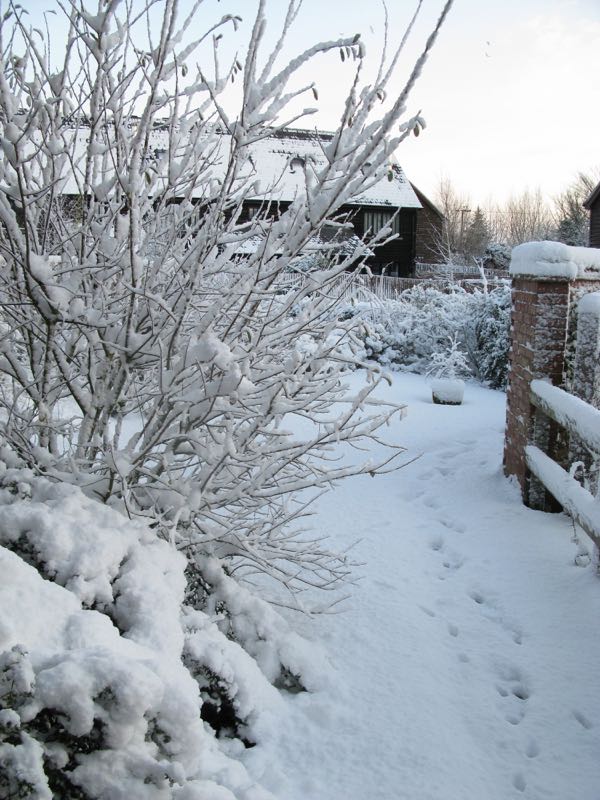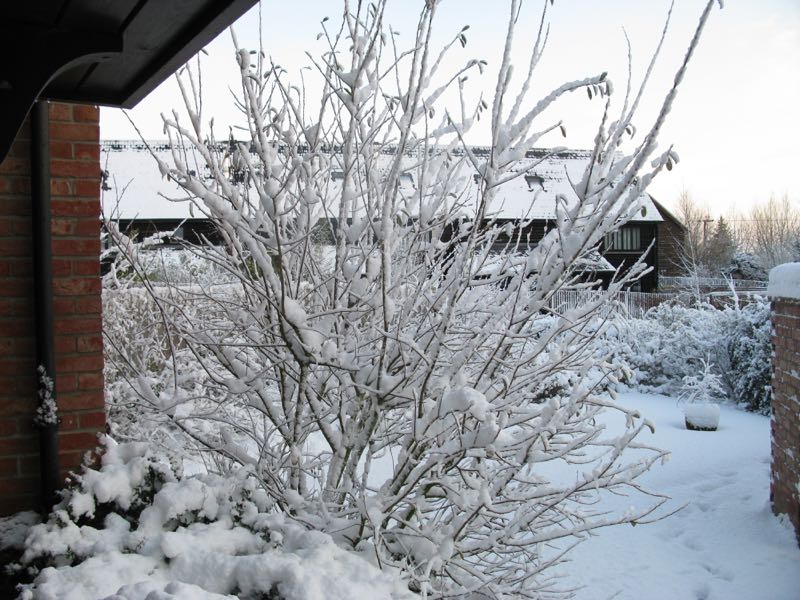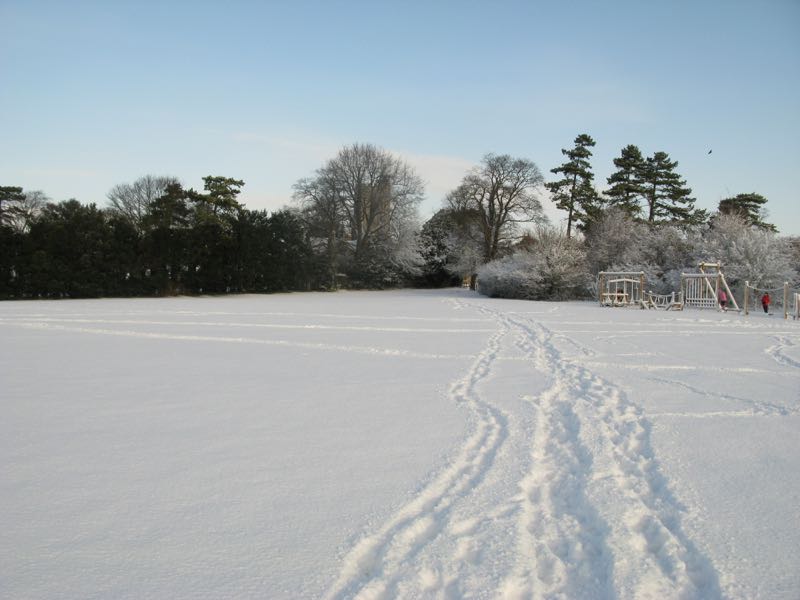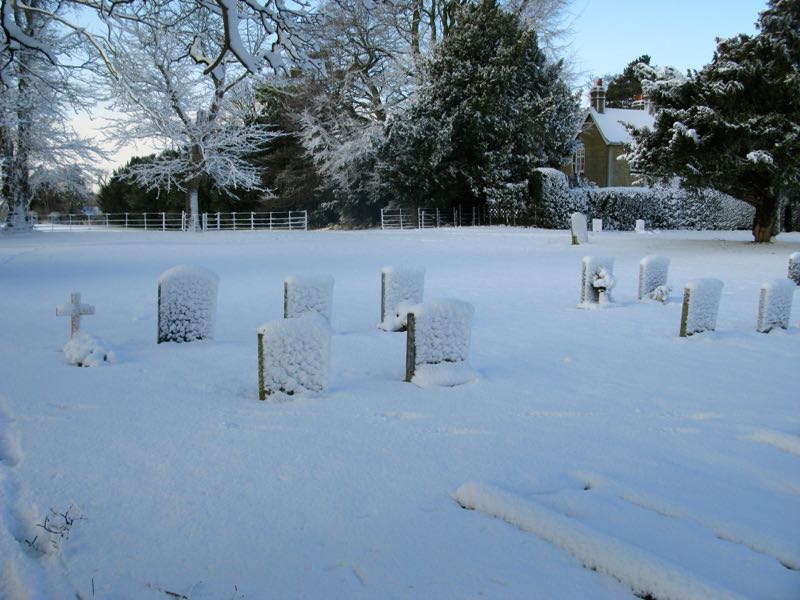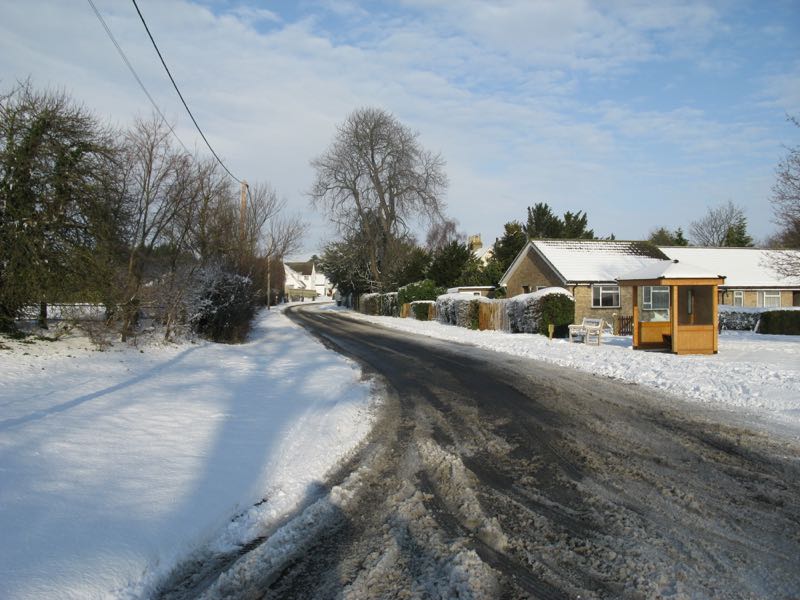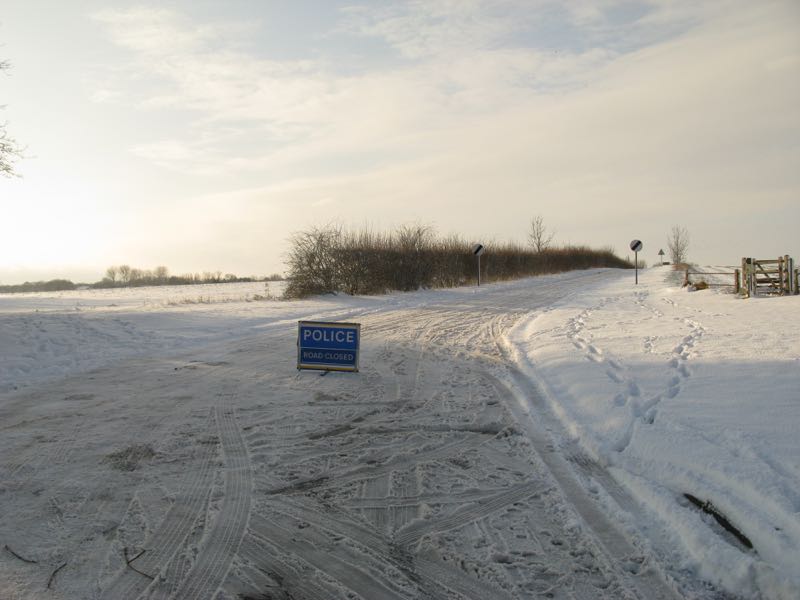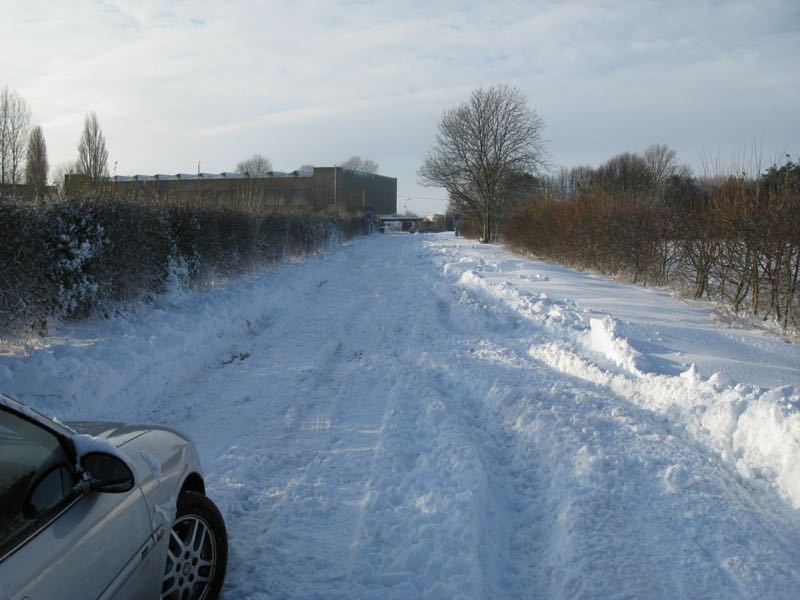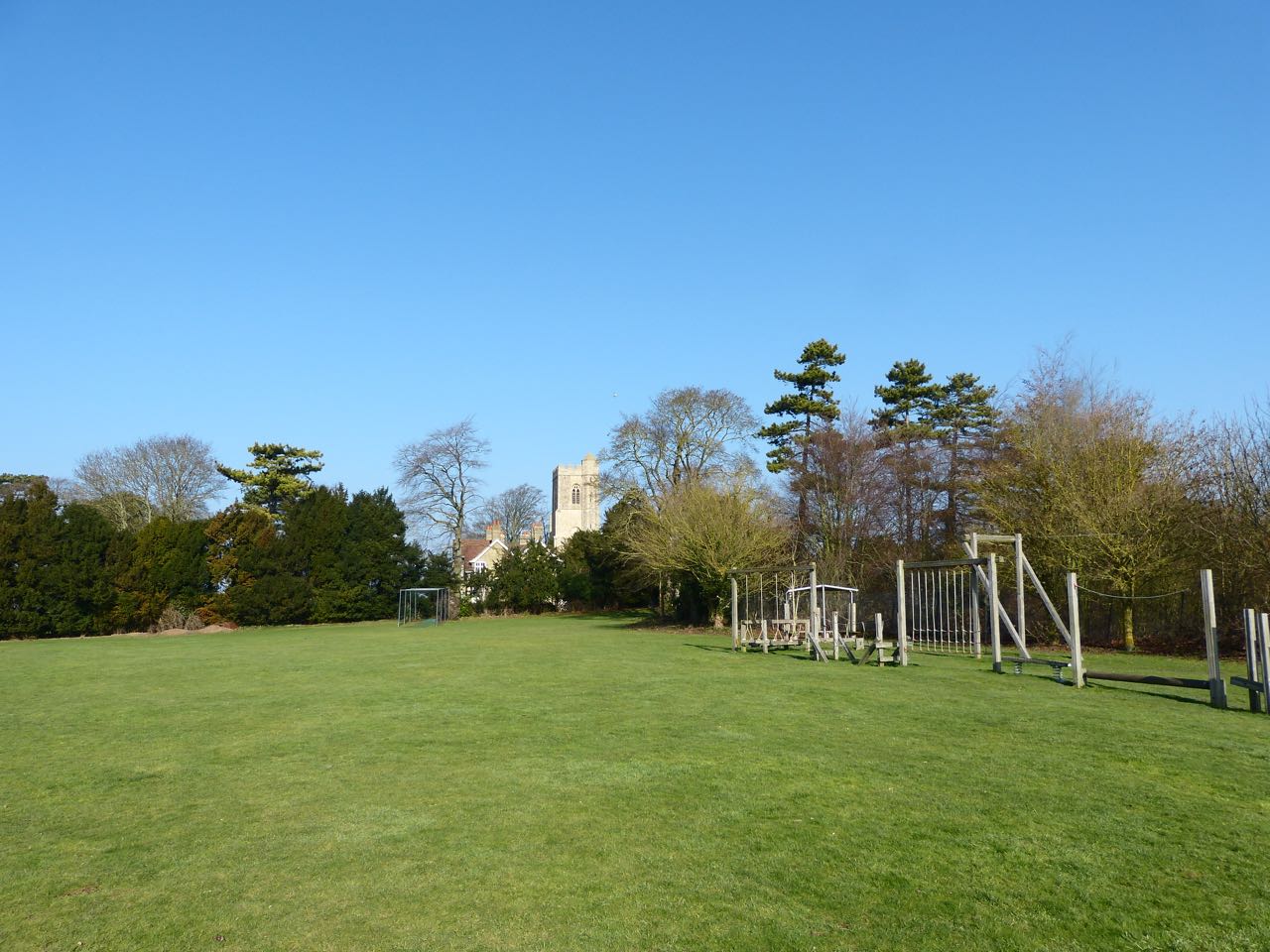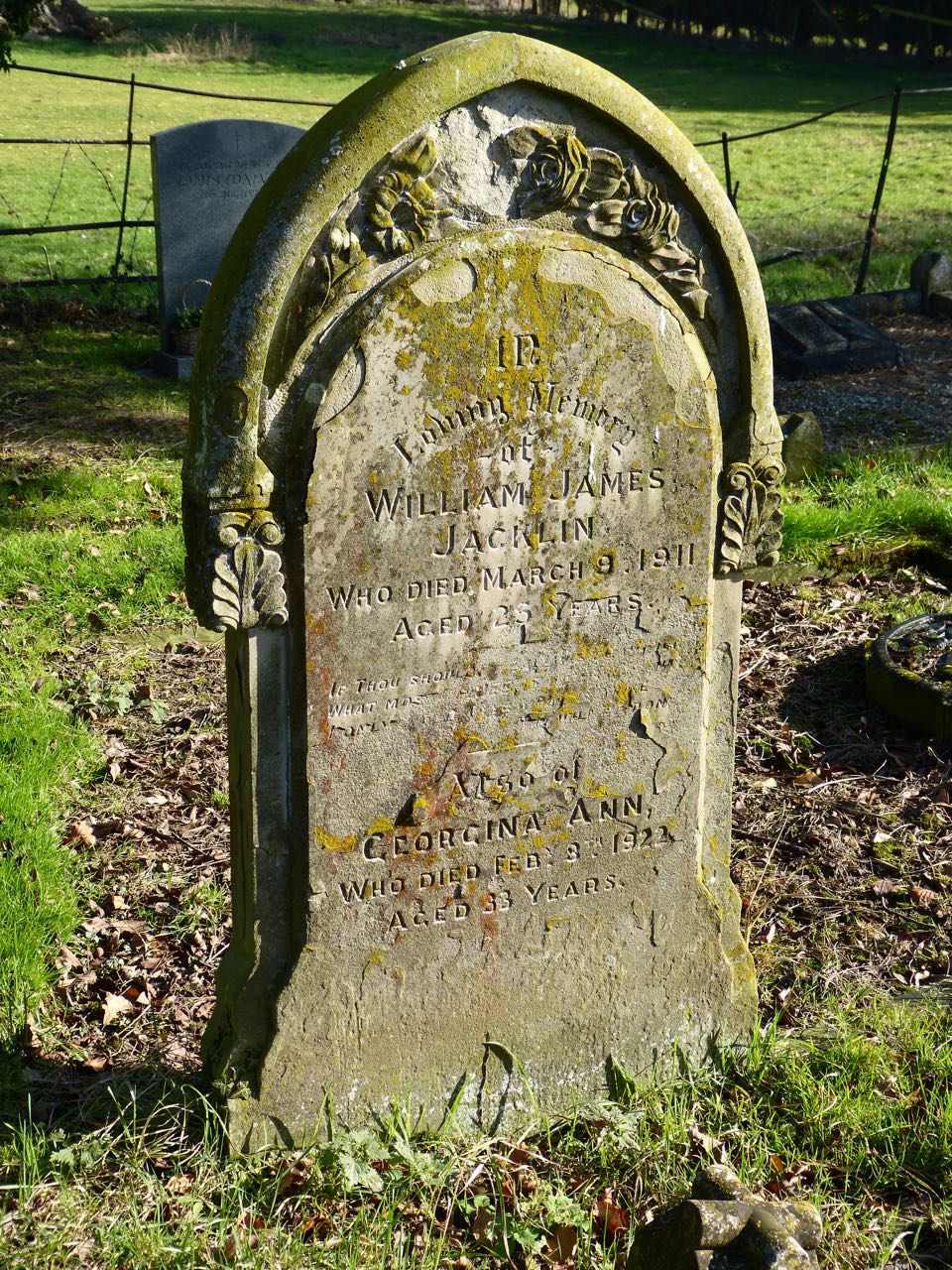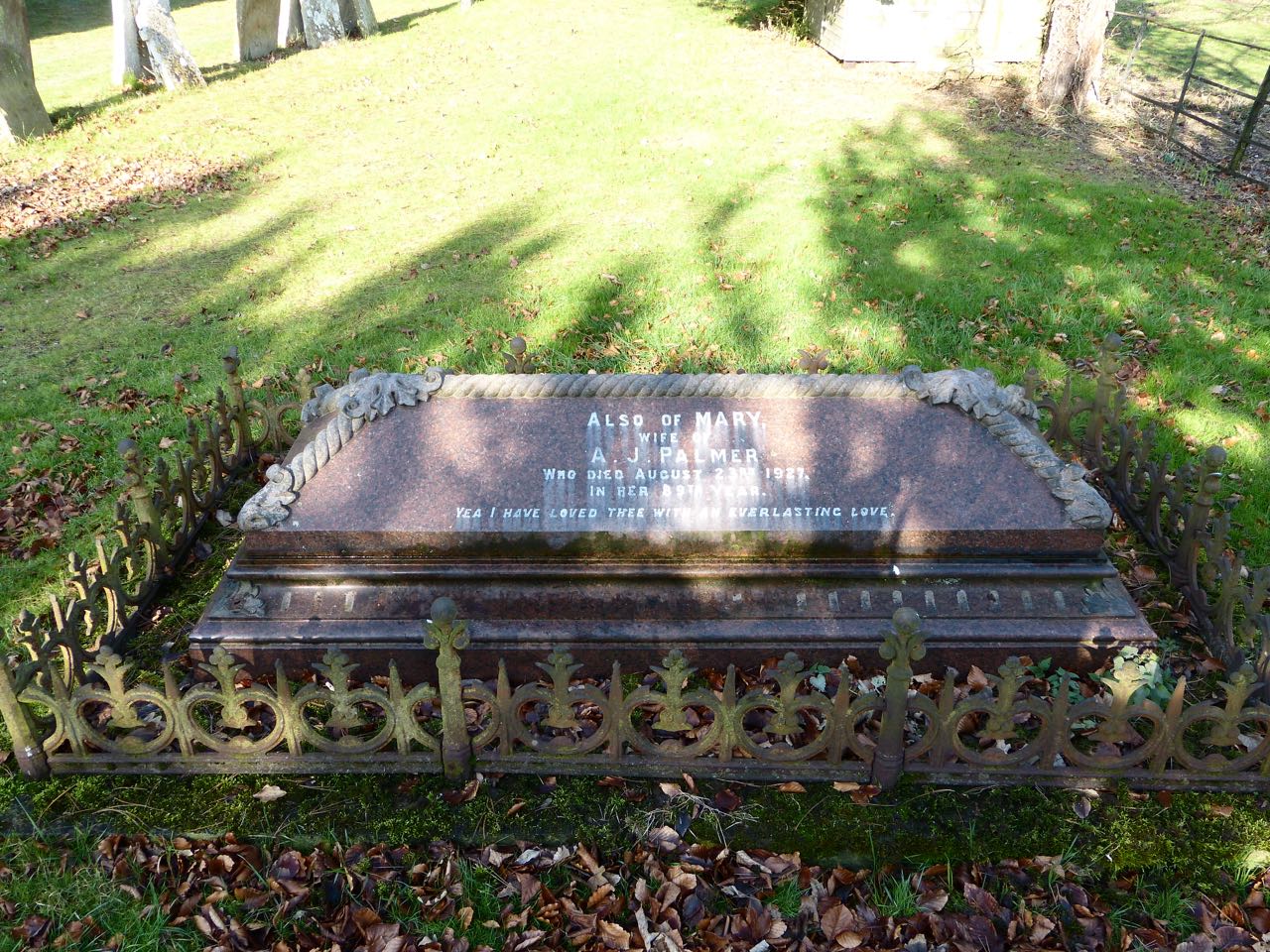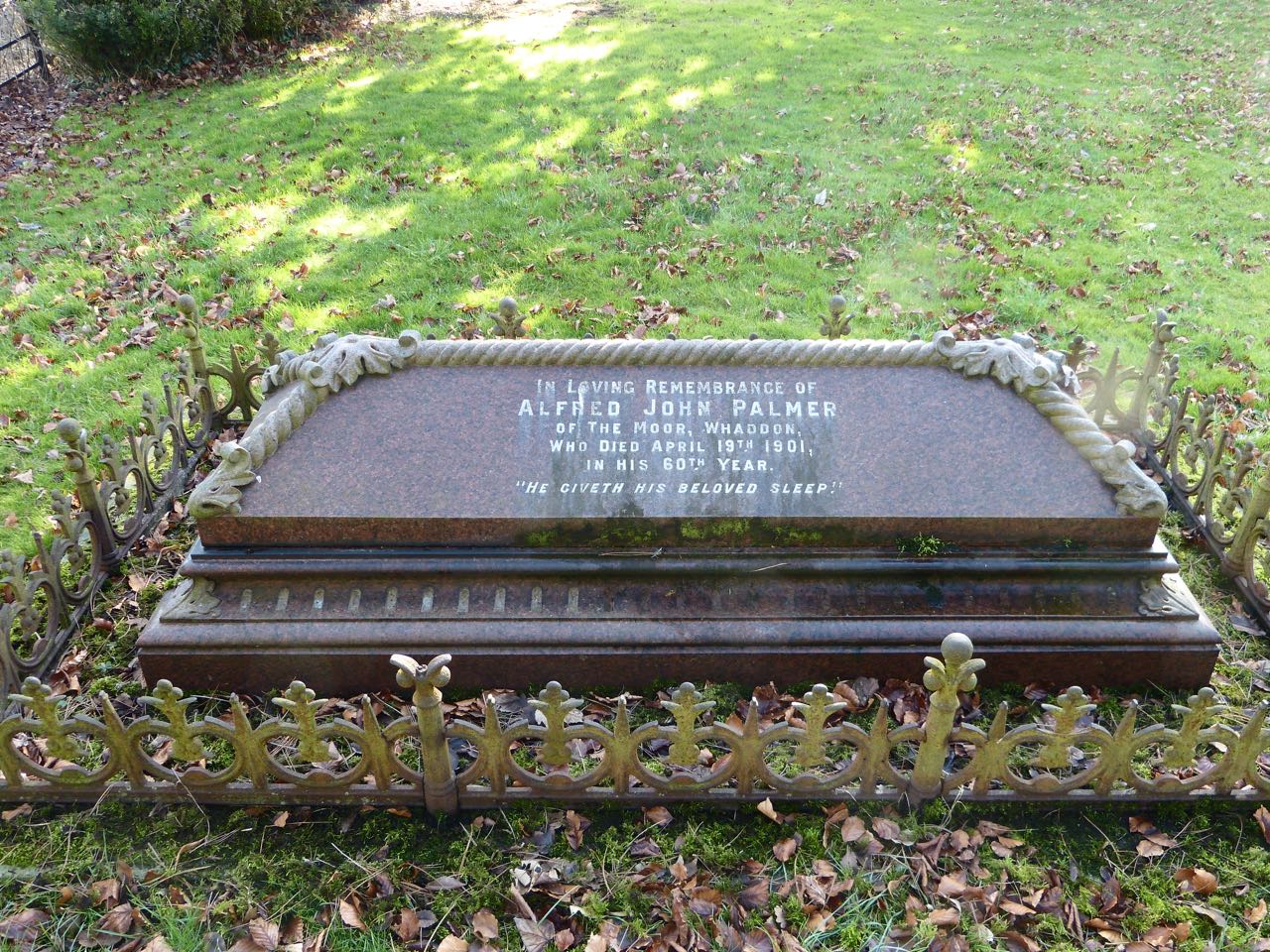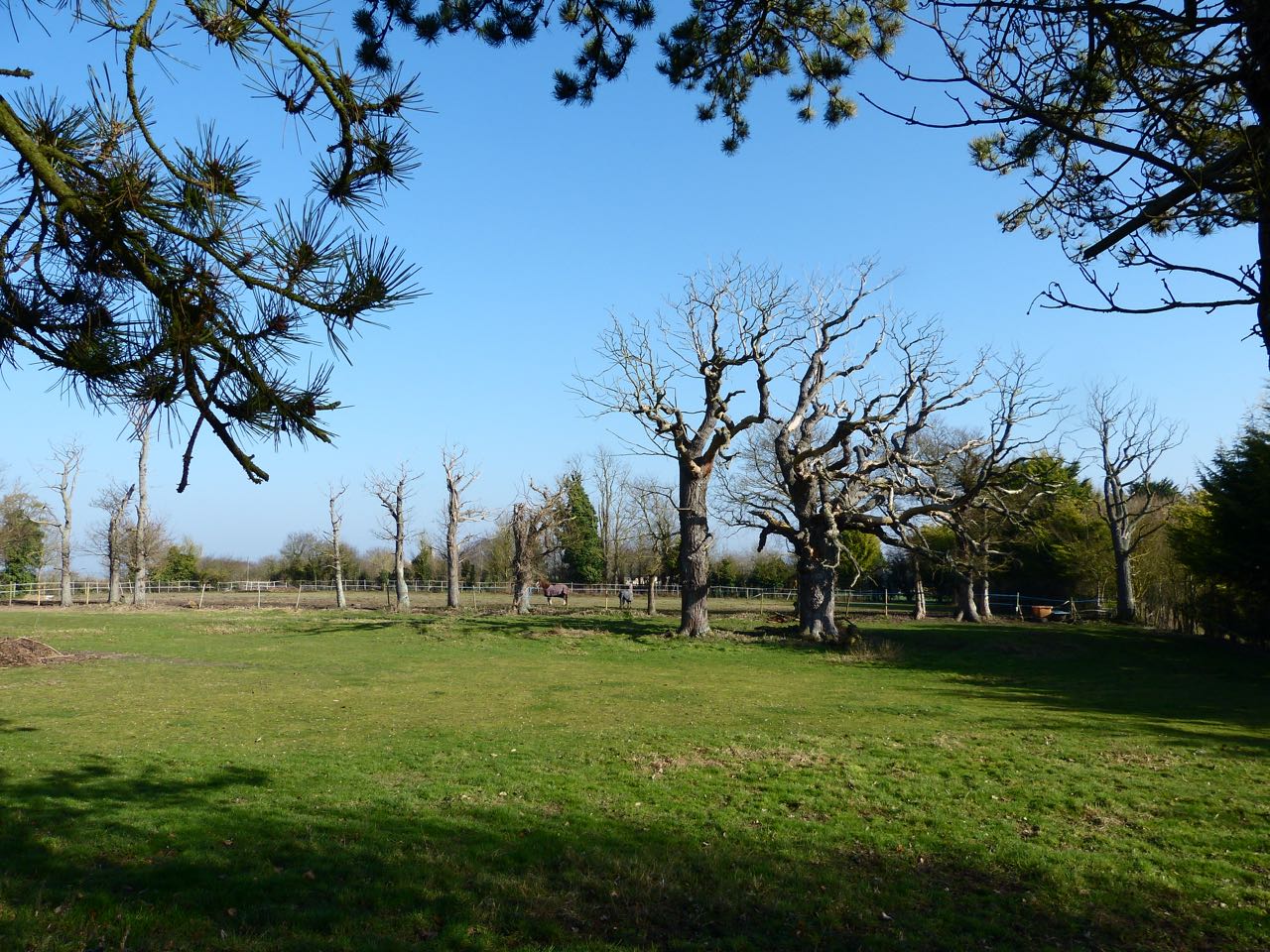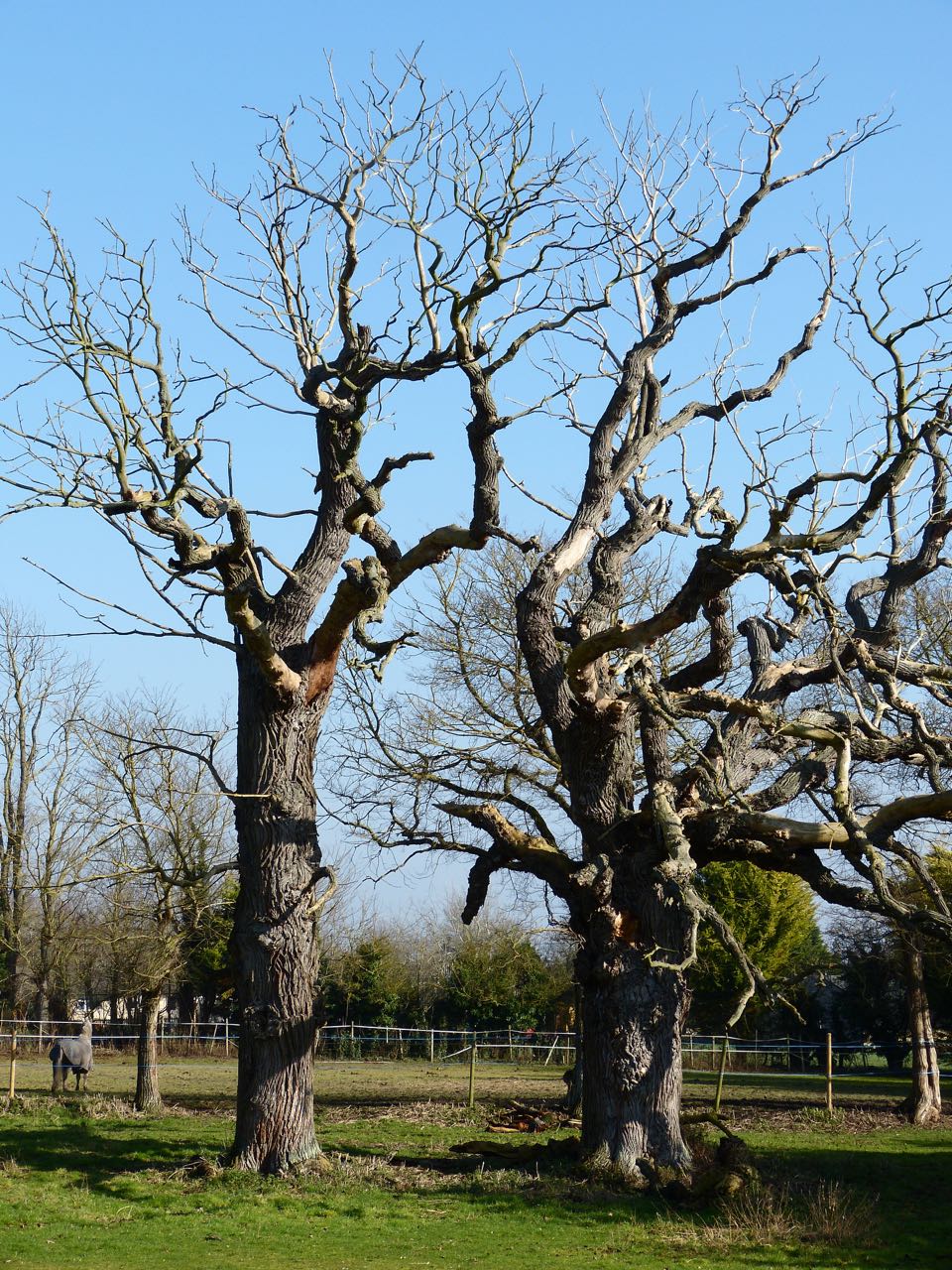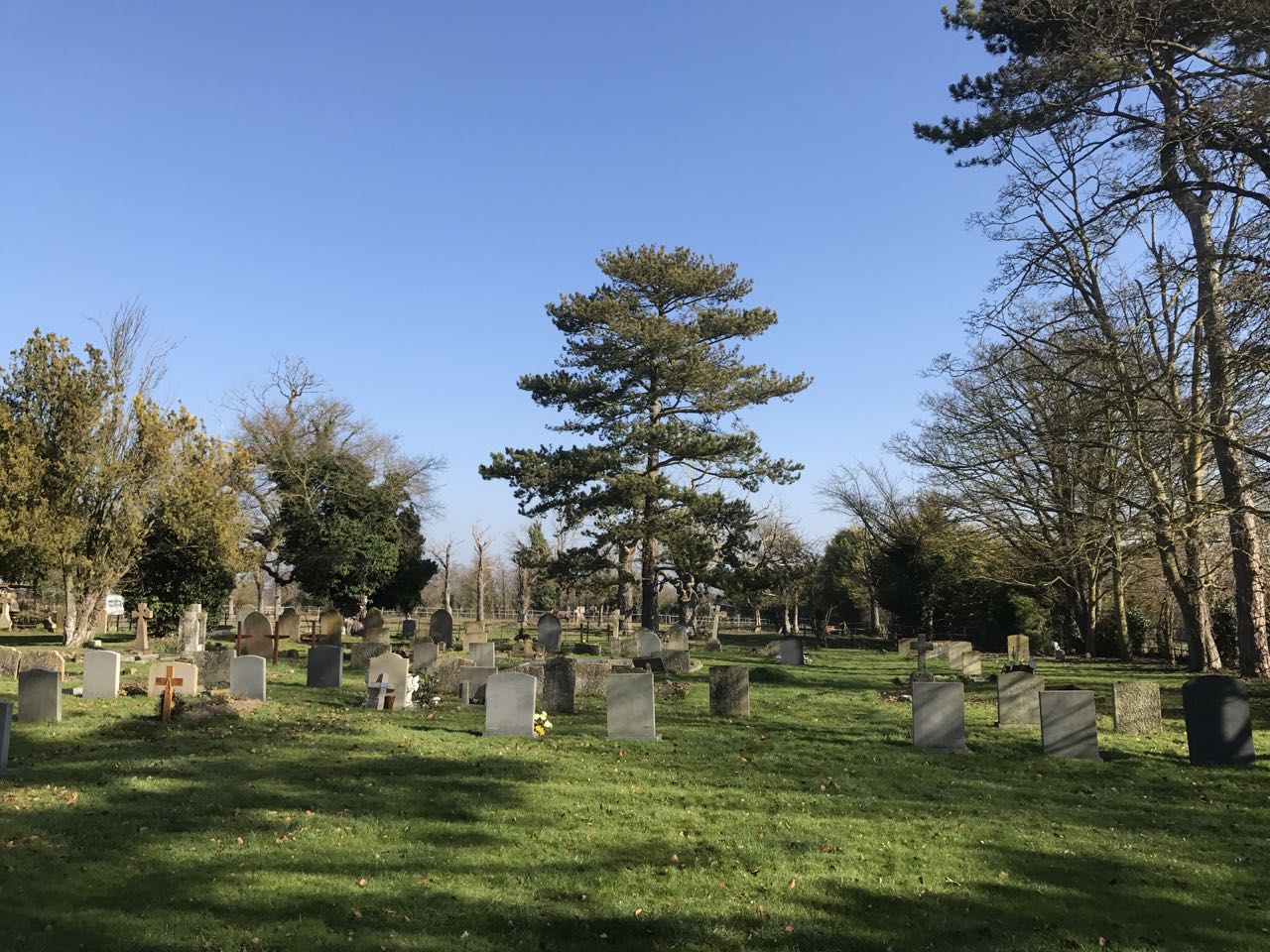



WHADDON HISTORY, ARCHIVES, PHOTOS
Updated Wednesday 12 February 2025
Whaddon is fortunate to have had two residents, Stan and Jean Ralls, who were very interested in the history of the village. You will find their village history below; now we are starting to add the detail of their work, and other more recent sources, to the web site. In particular, David Grech, a retired conservation architect who lives in the village, has added several very helpful Fact Sheets about Whaddon. This page also holds photographs taken of recent times in the village that do not appear elsewhere.
A Brief History of Whaddon
S. & J. Ralls (© 2005)
This history was originally written for the village information booklet in 2005, some of which is now online. Stan and Jean Ralls for many years were the village historians. When they moved out of the village, their archive material was left in the care of the village. This material still has to be fully explored and where possible put on this web site.
Click on the different section headings below to see them.
A really important source, compiled in 1982, that all interested persons should read, is the pages on Whaddon in the Victoria County History, London, 1982. This is now online.
Photos
Photos © Tony Gardner and Helen and Nigel Strudwick
Updates
The Ralls did a fabulous job of the history in the information booklet, but, as ever, time does not stand still and updates are now needed. Readers should note that we have left the text as it was when it was written. As an interim step, each of the following sections will in time have an [Update] section to bring things right up to date. Please also see David Grech's Village Fact Sheets (added May 2020) which have their own tab above on this page.
-
Whaddon is an extremely old village and its actual origins are uncertain. The green from the north end of Bridge Street eastwards to the Meldreth Road has been recorded as pre-Anglo Saxon. Although there is no archaeological evidence, it was part of the Anglo-Saxon administration belonging to the Armingford Hundred. Its court may have met at Mutlaw, later Mettle Hill between Meldreth and Kneesworth and the village is well documented in the Domesday Book of 1086. Its name derives from Wheat-hill (hwaete dun), but in spite of its name the village is almost flat rising only to about 23m at its highest point.
After the Norman Conquest of 1066 the village was one of the principal residences of Hardwin de Scalers, a member of the Norman aristocracy, amongst whom William distributed land. His family held a great deal of land both in Cambridgeshire and Hertfordshire. His residence was Sealers manor. This remained with the family passing through several generations until 1467 when the last male member of the Descaler's family was survived by three daughters and through marriage it passed into the hands of John More. Again through another marriage it came to the family of William Tempest. The estate was later acquired by Henry Pickering in 1648. He was a colonel in the New Model army who was knighted in 1660/1. It then passed to his son, also Sir Henry, who was married twice; the second time to a Grace Sylvester, heiress to a plantation owner in Barbados. This Sir Henry died in Barbados in 1705 and his body was brought back for interment in Whaddon. His wife later sold the estate to Edward Hariey, Earl of Oxford in 1716 and thereafter it remained with the Wimpole estate. Dame Grace gifted the clock, a bible and pieces of silver plate and her Turkey carpet to the church.
The manor stood on the south-east of the church and was eventually demolished in the early 1800s. Traces of its foundations can be seen under the driving range at the golf course along with the remains of an avenue of elms. A set of its gates are to be found in Royston at the Fish Hill entrance to Priory Gardens and the second pair reputedly stand at Wimpole Hall in Arrington. Other manor houses, now disappeared, are named in records of the village and traces of their moated sites remain.
-

The oldest building in the village is of course the church of St Mary (see separate menu item), which has had various additions and restorations dating back to the late 14th and 15th centuries. It is a very attractive church and has many interesting features; a splendid organ; a beautiful oak roof with carved bosses; many internal carvings supporting the roof and stained glass windows. These windows were installed after renovation work in 1869; one in memory of the Beaumont family, long term residents of Town Farm in the late 1800s and the second provided by the residents of the village. There are several memorial tablets in the floor of the chancel to the past residents of the manor and an altar tomb to the last of the Descalers. The font is octagonal and bears the coat of arms of the Descalers. The church also contains the memorial to the fallen in the two world wars and many gifts from parishioners in memory of loved ones. Several items are dedicated to the Coningsby family who have been in the village since 1878. There is a fine altar frontal and a matching pulpit fall dedicated to the memory of the late Paul Clarke, churchwarden, who came to Whaddon in 1983. The exterior of the church is equally attractive being decorated with many interesting carved figures under the battlements.
-
Whaddon has always been a small village with a fluctuating population of between 150 to 300 (except for a sharp increase at the end of the nineteenth century) and during its history has been involved in arable, dairy and sheep farming varying in prosperity with the general national situation. For example, with the advent of the Industrial Revolution in the late 1700s to early 1800s, there was an increased demand for food in the towns and cities and farming prospered but by 1841 the parish was generally very poor, mechanisation having begun to decrease the manpower needed on farms. At the time of the Poor Law of 1834 Whaddon became part of the Royston Union, the workhouse being situated on the Baldock Road in Royston overlooking the heath.
The village's farms were gradually enclosed and hedges were planted and many people whose livelihood had depended on the open field system left the village to find work and during the ensuing years some families in the area emigrated to America with the Mormons.
However from the 1860s the extraction of coprolite provided alternative work for agricultural workers in Whaddon and several farms became involved - Christ's College Farm, Hoback Farm and Rectory Farm. Coprolite is the name given to phosphatic nodules 'a stony roundish fossil, consisting of the petrified excrement of an animal' and used as fertiliser. Whaddon was one of the places roughly in a line Soham to Royston where the coprolite appeared. The workers were housed in a row of cottages obtained from the Earl of Hardwicke (by this time the owner of the Wimpole Estate) called Home Cottages on the Meldreth Road. In the 1871 census the population was 384, the coprolite workers making up 49.6% of the village workforce. The work gradually declined until 1891 by which time 400 acres had been dug. Some of the workers had to apply to Royston Workhouse for assistance.
-
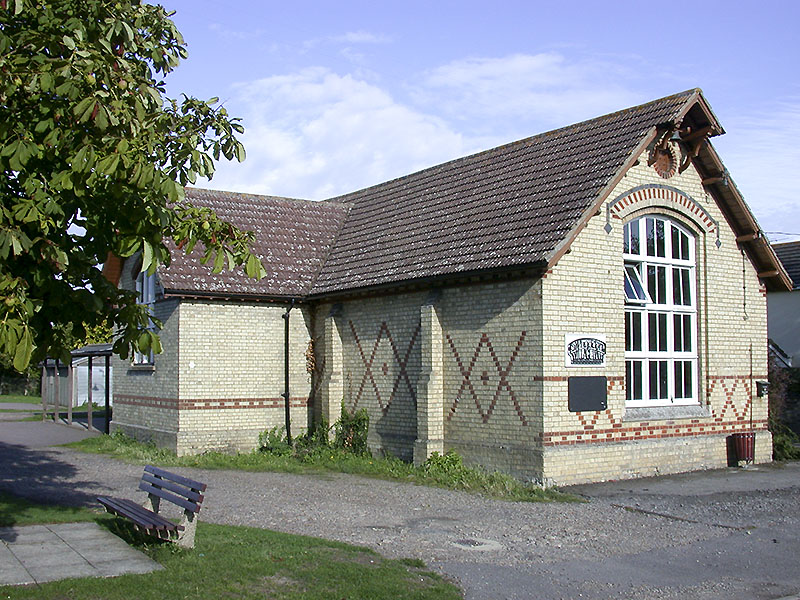
There have been schools of sorts in Whaddon since the 17th century but the most recent school was that in the Schoolroom which was given by Lord Hardwicke in 1875. From 1914 attendance fell steadily until in 1938 there were only 38 pupils. Seniors were transferred to Meldreth and Bassingbourn in 1924 and later attended Bassingbourn Village College when it was built in 1954. In 1962 the juniors were transferred to Orwell Petersfield school and Whaddon school closed. It was thereafter used as the village hall which it is hoped will be redeveloped in some way in the near future. [Update: this has of course happened — see menu item for Village hall]
[The following image shows the children of the school with their teacher in 1911. I am grateful to Bob Giddings for passing this on.]

In 1962 the village recreation ground was established and formerly opened by Jim Law, Chairman of the Parish Council for many years. There is a hawthorn tree there in memory of Agnes Woodcock who was secretary to most village organisations for many years and the chestnut trees were planted in 1976. Throughout the village there is still a tree planting initiative. The seats were placed there to commemorate the Queen's Silver Jubilee in 1977. A children's playground has been developed over the years.
-
A Methodist chapel was housed in Home Cottages, the former home of the coprolite workers. This was burned down in 1935 and replaced on the present site, where it flourished until July 2002 when it closed for lack of a congregation. The Hymn board in the chapel commemorates the life of Mollie Hale, who played the organ regularly for 60 years and who was also involved in many fund-raising activities for village improvements. This board is now to be found in the parish church. The premises are now home to the new venture Bumpkins.
-
The post office in the village has been situated in various locations - presently it is operated on a part-time basis in the Golf Centre. In the past there has been a small shop but villagers had to rely on visiting tradesmen from neighbouring parishes. There were public houses. The Queen Adelaide on the Meldreth Road, which was recorded in Royston Brewery records in 1876, ceased trading as a public house in 1956 on the death of the last tenant. The Waggon and Horses (later The Antelope) at Whaddon Gap, ceased trading in the 1990s, the original timber building first recorded in 1876 having been replaced in 1938. Much earlier there was The Home or New Found Out the beer-house which catered for the coprolite workers and before 1900 the Pickering Arms which later became a farm. This farm, which was subsequently burned down in 1963, stood on the site of the present Pickering Farm opposite the recreation ground.
-

There are in the village several listed thatched cottages. These are now substantial houses but initially were made up of two or three individual dwellings. Also listed are some of the old farmhouses most now occupied as private dwellings. Various features on these old farms such as granaries, a fountain and a dovecote and a tunnel mill are also listed. All the buildings are Grade 11 listed but the church itself is Grade I listed. Only two of the original farm houses remain as farms: Rectory Farm and Hoback Farm, which are in private hands. Cambridgeshire County Council owns the other three farms which remain in the village. Most of the
modern
houses were built after the war except for four council houses in Bridge Street which were constructed for the men returning from World War I.Whaddon remained unchanged for many years. Water was obtained from the natural springs which ran at a speed which would fill a pail in 30 seconds. There were at least 13 such springs. Most of these have now disappeared or been turned into decorative features. Only one remains as an alternative to the mains supply. Some water was piped into the village in 1938 after the arrival of the Atlas Stone Company (now Eternit) which bored much deeper stopping the fountains. Other piped water was installed after World War II. The fountain in Bridge Street underwent refurbishment in 2005. It is now in working order and the surrounding area has been enhanced by the addition of a seat and plants. This is in memory of former Chairman of the Parish Council, Frederick Bradley.
Electricity was installed in 1948 and mains drainage arrived as late as the 1970s to replace the septic tanks.
-
The war years were brought closer to Whaddon by the use of Bassingbourn airfield as a bomber base by the R.A.F. and the Americans and it remained in the hands of the R.A.F. until it was taken over by the Army. The stained glass window in the east wall of the church was damaged during the war. The village had its own Home Guard unit carrying out the usual duties.
[Images of the war memorial to both World Wars will be found in the Guide to St Mary's Church.]
-

One old recorded tradition was the singing of the Whitsun Song. This was sung by men who placed a twig of oak in the roof of each house. The singers wore knee stockings, breeches, rosettes and ribbons, similar to Morris dancers. It was the custom for singers to walk via Kings Bridge, across the Cam, to Orwell to perform there after doing the rounds in Whaddon. [This tradition was revived in 2005.]
There are two fêtes each year. Since the 1940s a fête and produce show has been organised by the church to raise funds. A fête and barbecue are held annually on the recreation ground to raise money for the village hall. At Christmas all children under the age of eleven are invited to a Christmas party in the village hall, a tradition which dates back well over forty years.
In the past there has been a branch of the Women's Institute and at the present the Whaddonians, a club for the over sixties, continues to function.
Throughout the life of the village all national events such as coronations and jubilees of sovereigns have been celebrated with enthusiasm, the local newspaper, the Royston Crow, recording them faithfully. There is no reason to suppose that such events did not take place before the newspaper began in 1855. Sport was a regular feature of village life. Cricket took place on what is now the first tee of the Golf Course and the village managed to provide its own football team for many years.
-
The village has its own charity, the Alfred John Palmer Trust which was set up by the will of his widow in 1927. She left the income of £200 stock to be given in coal to Whaddon widows. Whaddon has a long tradition of regular door to door collections for charity and the one for the Red Cross dates back over 100 years.
[See now the adjacent archive tab for more information and photos.]
-
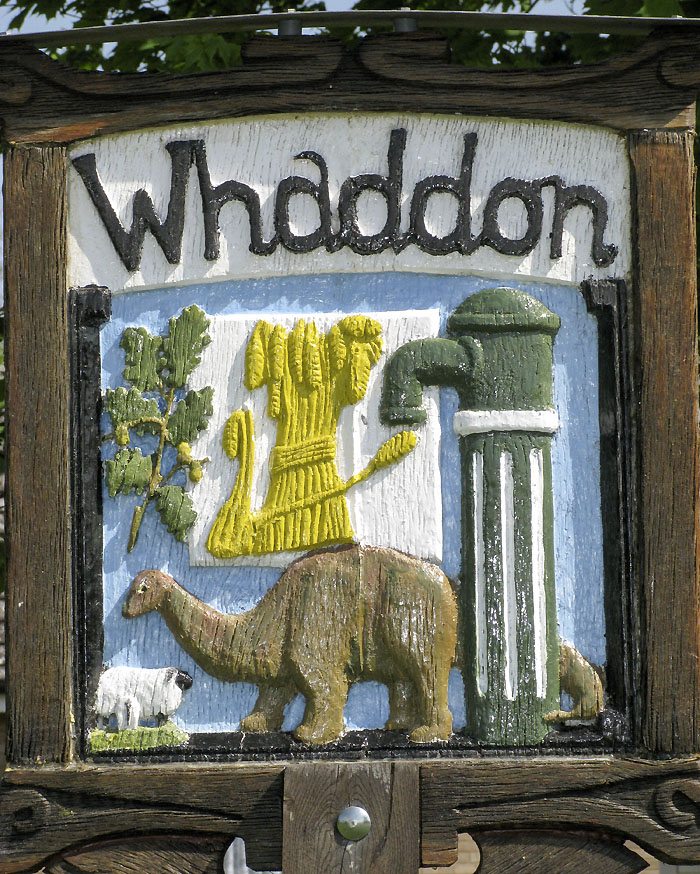
The village sign at Ridgeway corner encapsulates the village history. It was unveiled by the late Lord Whaddon in October 1994 and the sign was designed from ideas submitted by villagers. The sheaf of corn represents wheat hill; the dinosaur, the coprolite industry; the fountain, the springs; the oak branch, the Whitsun tradition. Under the sign is a seat dedicated to Jim Law who spent the whole of his 81 years in Whaddon and who gave unstinting service in many areas not least the Parish Council of which he was chairman for over 30 years.
The development of the village has recently begun to accelerate and its population is rising as it increasingly absorbs small businesses such as the Golf Centre, Nippers, Bumpkins, light industrial units and new housing into its fabric. It is inevitable that its character will change but its roots will always be firmly fixed in the distant past.
[Update December 2016: the current Village Sign has probably reached the end of its life. It has been cracking and has been checked over and is presently thought to be beyond repair. A new sign was voted on by the village, and was unveiled on 20 April 2019.]

-
A P Baggs, S M Keeling and C A F Meekings, 'Parishes: Whaddon', in A History of the County of Cambridge and the Isle of Ely: Volume 8, ed. A P M Wright (London, 1982), pp. 142-151. British History Online http://www.british-history.ac.uk/vch/cambs/vol8/pp142-151 [accessed 20 January 2017].
Cambridge Collection
Royston Crow
It is intended to add a series of entries on various history things where we have material and where they do not feature elsewhere. Thus cricket history is primarily to be found on the Cricket page, and present and past newsletters are on The Whaddon News page.
-
The Home is now a set of houses on Meldreth Road in Whaddon. It began life as a licensed Beerhouse for coprolite workers, probably built around 1870 and was formed of a substantial house, bar and clubroom, and six cottages. As the coprolite industry faded, it ceased this use in 1898. In 1900, the bar and clubroom became a Methodist Chapel; around 1915 the house became a farmhouse, and Holme Farm came into existence. The land was owned by the Earl of Hardwicke (Wimpole Hall Estates) but he sold much of his land in 1891, including this plot (101). The farmhouse and chapel were destroyed by fire in 1935, and for many years the remains of the chapel entrance could still be seen.
The previous information and the following comes from Bob Giddings, an architecture professor in Newcastle, who is the great-grandson of Daniel Jacklin.
Daniel Jacklin (1838-1911) came to Whaddon as the Publican of The Home in about 1879 to 1881. Daniel’s youngest daughter was Emily Ethel (1881-1950). She married William Jarman (1888-1965) of the local well-established farming family and they turned the former Home into Holme Farm.
Bob has written a short book on the history of the Home, that also sheds light on many aspects of life in and around Whaddon. He has kindly agreed to have it available for download on this web site:
The Home, Whaddon, Cambridgeshire 1867-1935 (19mb PDF file NB there have been reports of this file not loading completely on mobile devices, so please use a desktop/laptop)
Below are a couple of images of the memorial to Daniel Jacklin in February 2017.
.
-

The coprolite mining industry was very important to Whaddon in the second half of the 19th century. So important in fact, that a dinosaur represents this part of the history of the village on the [now taken down] village sign. The connection with the dinosaur is due to the common belief that coprolites are the fossilised dung of these creatures, and they can be in some cases, although research now suggests that those in our area are more likely from larger marine reptiles or fish (see below).
The importance of coprolites lay in the fact that the nodules that form them are rich in phosphorous, and can be dug out to form the basis of agricultural fertiliser, and this became an extensive, albeit short-lived, industry in various parts of the UK in the the 19th century. A fair bit of research has indeed been done, so rather than repeat it, we give you here a few web links that will tell you more:
-
Whaddon has its own charity, the Alfred J. Palmer Trust. Here is what the Ralls had to say in their History on the adjacent tab.
The village has its own charity, the Alfred John Palmer Trust which was set up by the will of his widow in 1927. She left the income of £200 stock to be given in coal to Whaddon widows. Whaddon has a long tradition of regular door to door collections for charity and the one for the Red Cross dates back over 100 years.
The Trust is very much a product of its time. With the passage of years, things have changed and grants have become fewer, and obviously the Trust's income is not great. In 2016, the Parish Council proposed modifying the Trust Deed to allow a wider range of grants to be made from the modest income. This should happen in the course of 2017.
Below are a number of photographs of archival materials now in the Cambridgeshire Collection, and also a couple of recent images of the tomb of Mr and Mrs Palmer in Whaddon Churchyard.
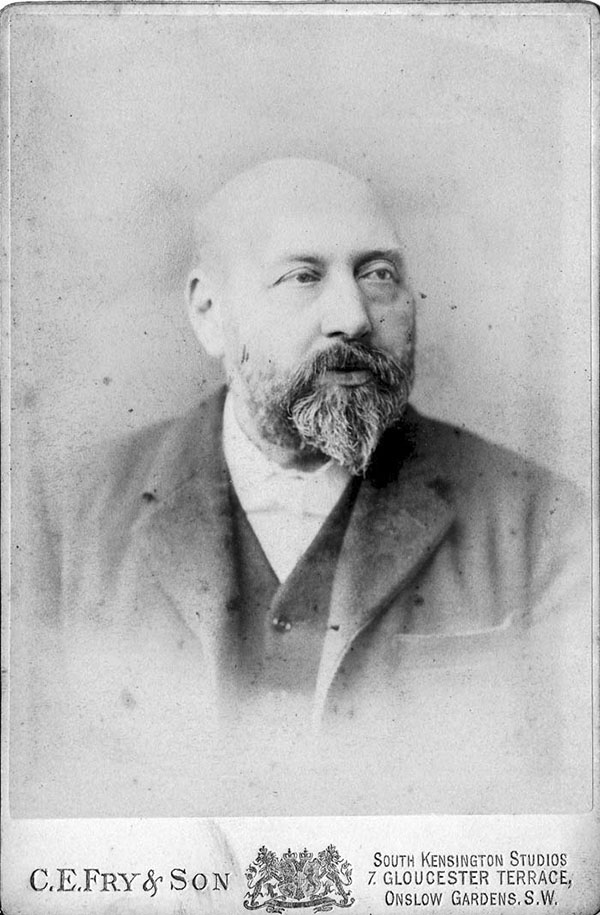 Mr Alfred John Palmer
Mr Alfred John Palmer Mrs Mary Palmer
Mrs Mary Palmer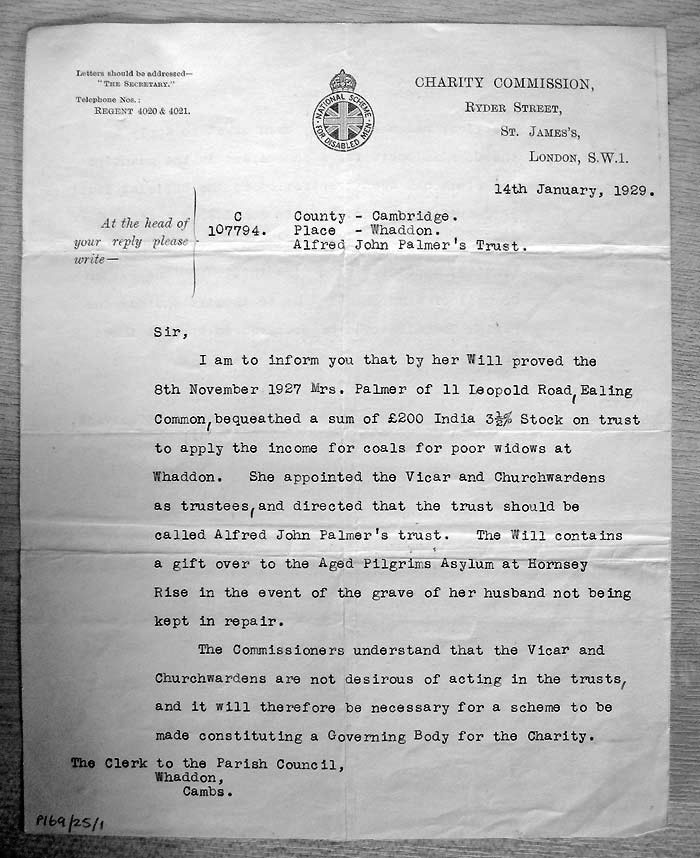 Letter from the Charity Commission about the Trust
Letter from the Charity Commission about the Trust Envelope indicating receipt of the Charity Deed
Envelope indicating receipt of the Charity Deed
Bill from James Jarman for maintenance of the Palmer tomb
 Side of Palmer tomb commemorating Mr Palmer❮ ❯
Side of Palmer tomb commemorating Mr Palmer❮ ❯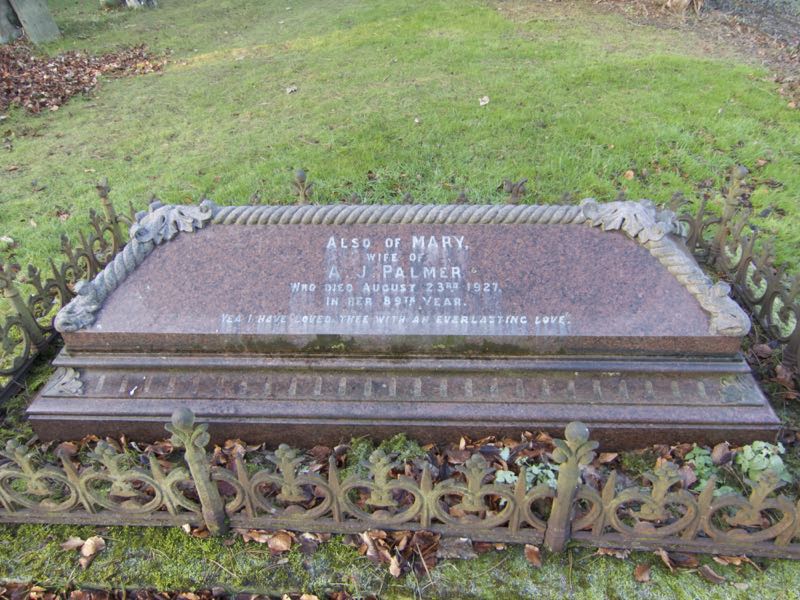 Side of Palmer tomb commemorating Mrs Palmer
Side of Palmer tomb commemorating Mrs Palmer.
-
Mike Petty is a local historian and expert in the Cambridgeshire Collection. He has put together various "scrapbooks" that summarise press coverage of local villages from the 19th century to 1990. His material is available via the Internet Archive; we have downloaded the Whaddon entry here and it is linked below.
David Grech, Whaddon's own retired conservation architect, has in April-May 2020 put together some Fact Sheets to summarise much about the history of the village and more information about the houses and the church itself. The following links will each download a PDF file on that particular topic.
Fact Sheet 1--Historical overview Fact Sheet 2--Historic houses Fact Sheet 3--St Mary's Church Fact Sheet 4--Farm buildings of the area Fact Sheet 5--The abandoned village of CloptonA selection of various images taken around the village at different times, mostly by your web master; again these do not specifically relate to subjects that have their own pages on the site.
-
With snow seemingly being a rarity in 2016, I came across these photos from December 2009. I remember it well; the village was for a couple of days cut off at the Bassingbourn end, and only those with four-wheel-drive vehicles, or a lot of luck, could get through...
-
Some photos from December 2010...
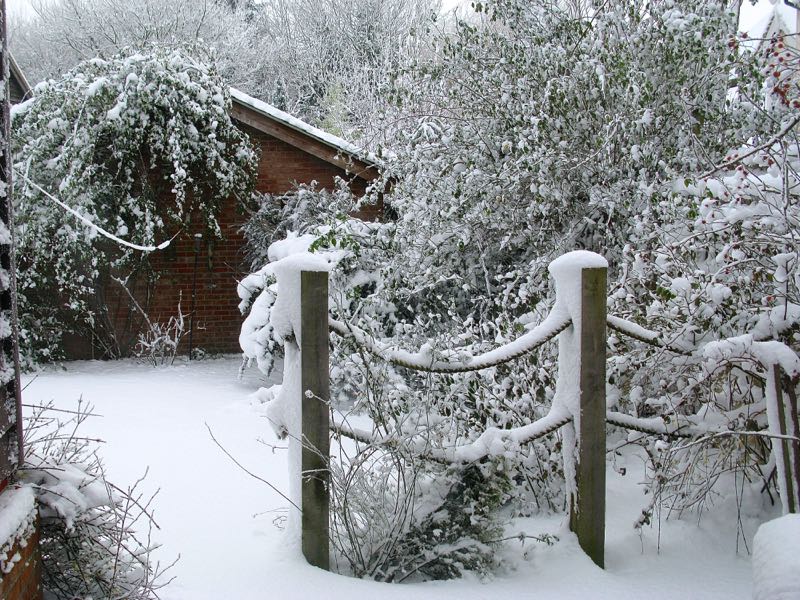 Our garden
Our garden The Recreation Ground
The Recreation Ground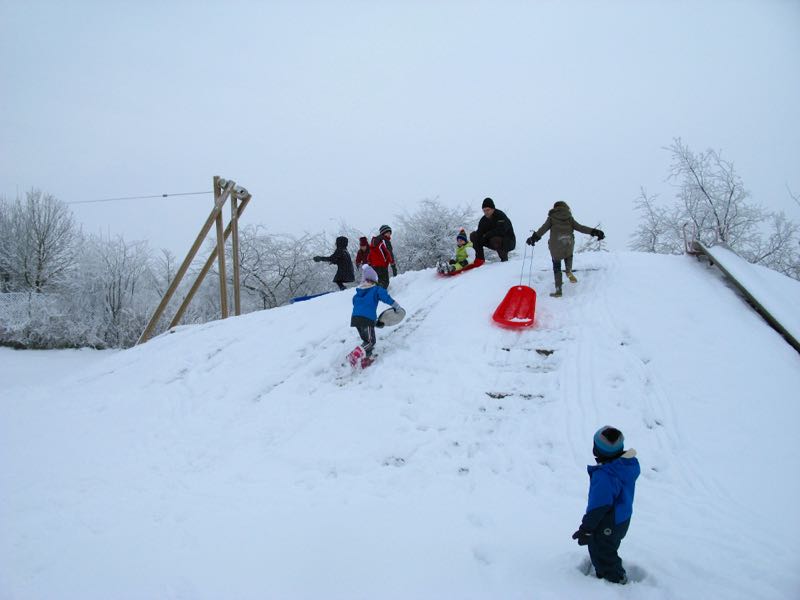 The play area as a toboggan run
The play area as a toboggan run Play equipment
Play equipment St Mary's
St Mary's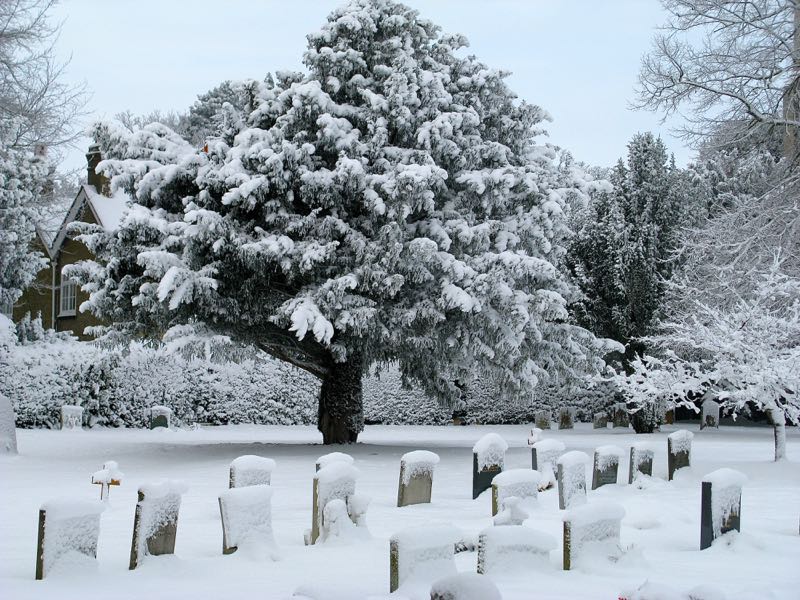 The churchyard
The churchyard One of our hardy four-legged residents
One of our hardy four-legged residents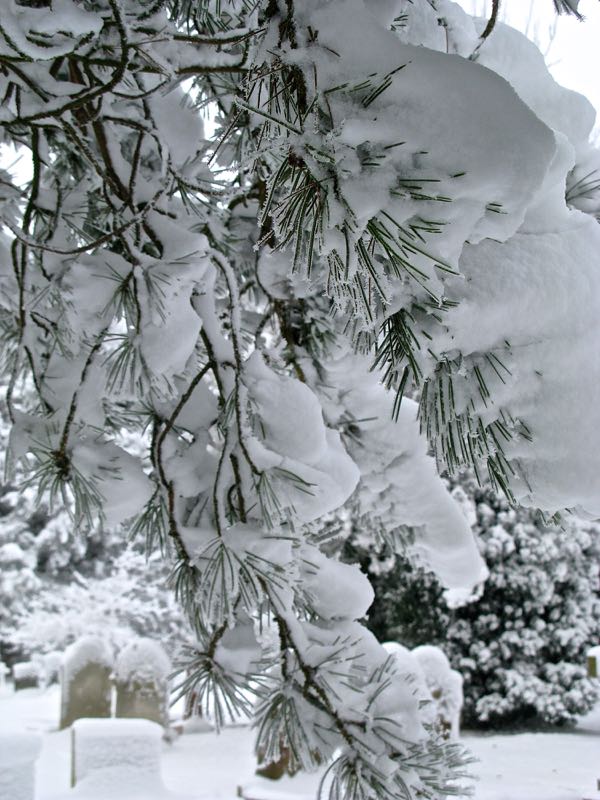 Art
Art The churchyard again
The churchyard again Church St in front of the church
Church St in front of the church St Mary's from Church St
St Mary's from Church St Be careful, but of what...
Be careful, but of what...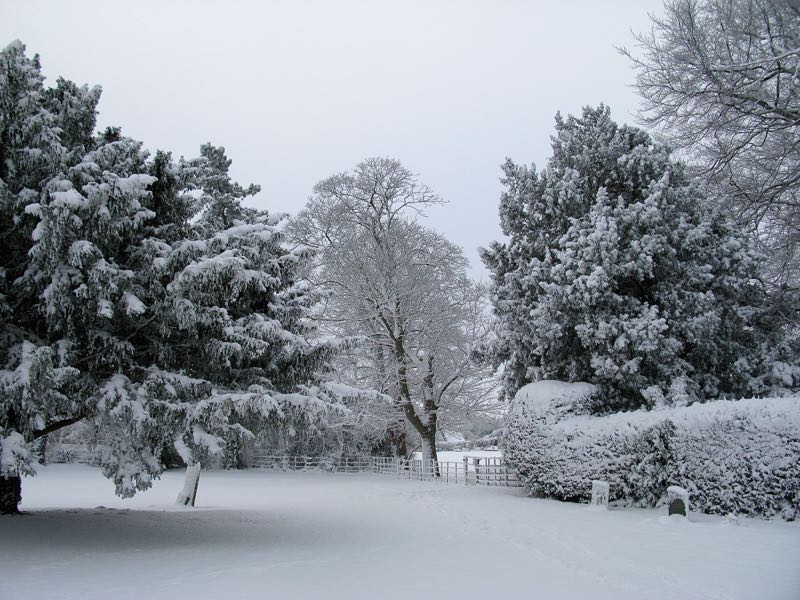 From the churchyard into the Rec
From the churchyard into the Rec The hardy churchgoers return❮ ❯
The hardy churchgoers return❮ ❯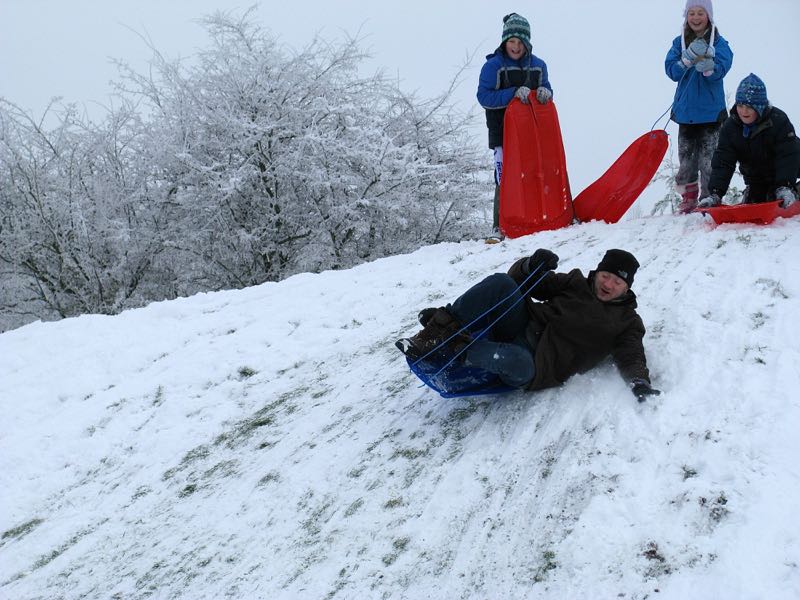 Peter Haselden showing how to ride a toboggan
Peter Haselden showing how to ride a toboggan -
Some photos from a walk on a lovely day in early 2017.


